Business Continuity Plan: Objectives, Purpose, and Importance
VerifiedAdded on 2023/06/11
|6
|1188
|192
Report
AI Summary
This report provides an overview of business continuity planning (BCP) and disaster recovery (DR), highlighting their importance in preventing and recovering from threats to an organization. It discusses the accessibility and implementation of BCP and DR, emphasizing the need to identify key assets and potential business impacts. The report also outlines the similarities and differences between BCP and DR, noting that while both share the same principles and assets, BCP focuses on preventing disasters, while DR provides solutions for already occurred problems. Furthermore, the report elucidates the objectives of BCP, which include providing guidelines for the disaster recovery team, identifying threats, and ensuring backup resources. It concludes with a recommendation for strict enforcement of developed policies and motivational rules for employees, stressing the importance of securing BCP to prevent misuse by competitors. This document contributed by a student is available on Desklib, a platform offering study tools and resources for students.
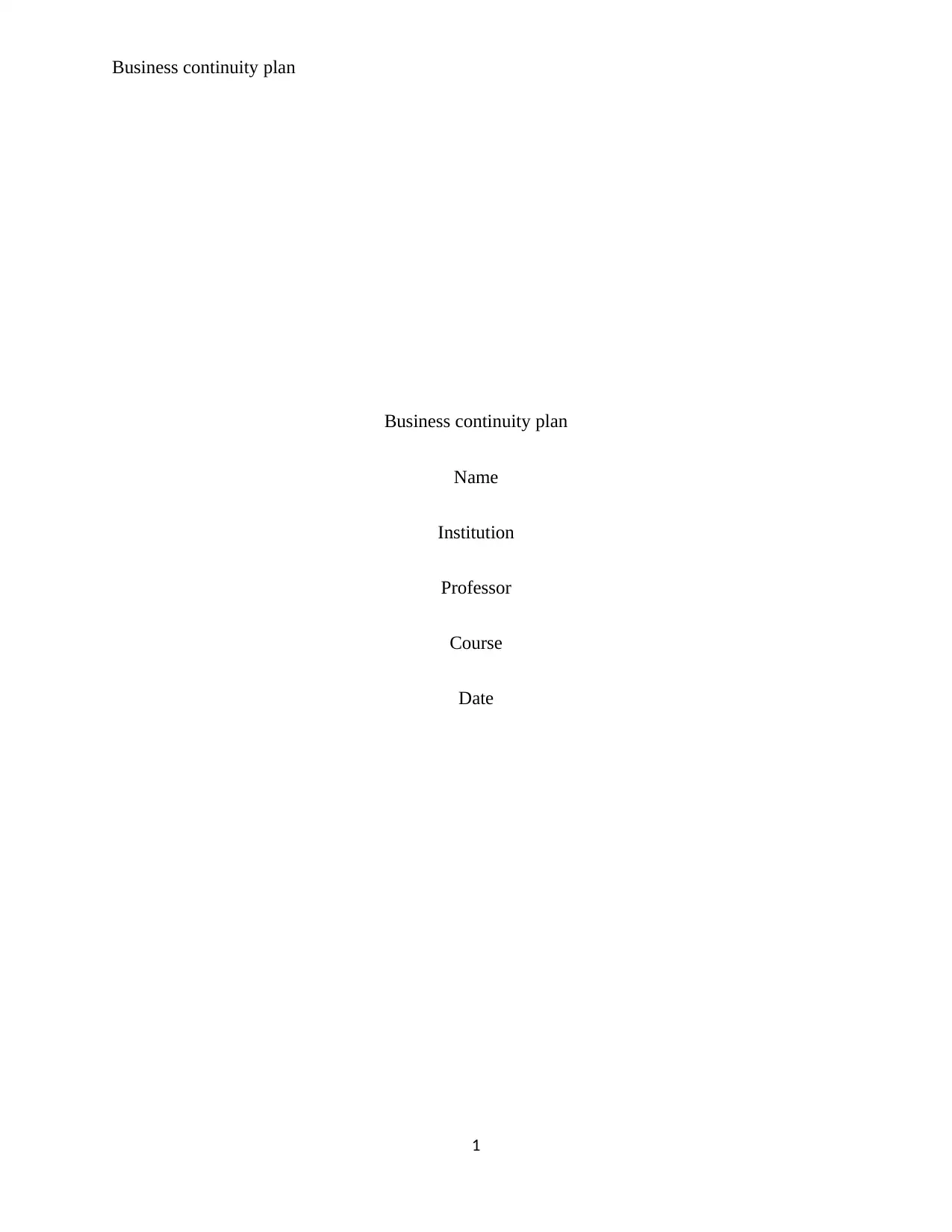
Business continuity plan
Business continuity plan
Name
Institution
Professor
Course
Date
1
Business continuity plan
Name
Institution
Professor
Course
Date
1
Paraphrase This Document
Need a fresh take? Get an instant paraphrase of this document with our AI Paraphraser
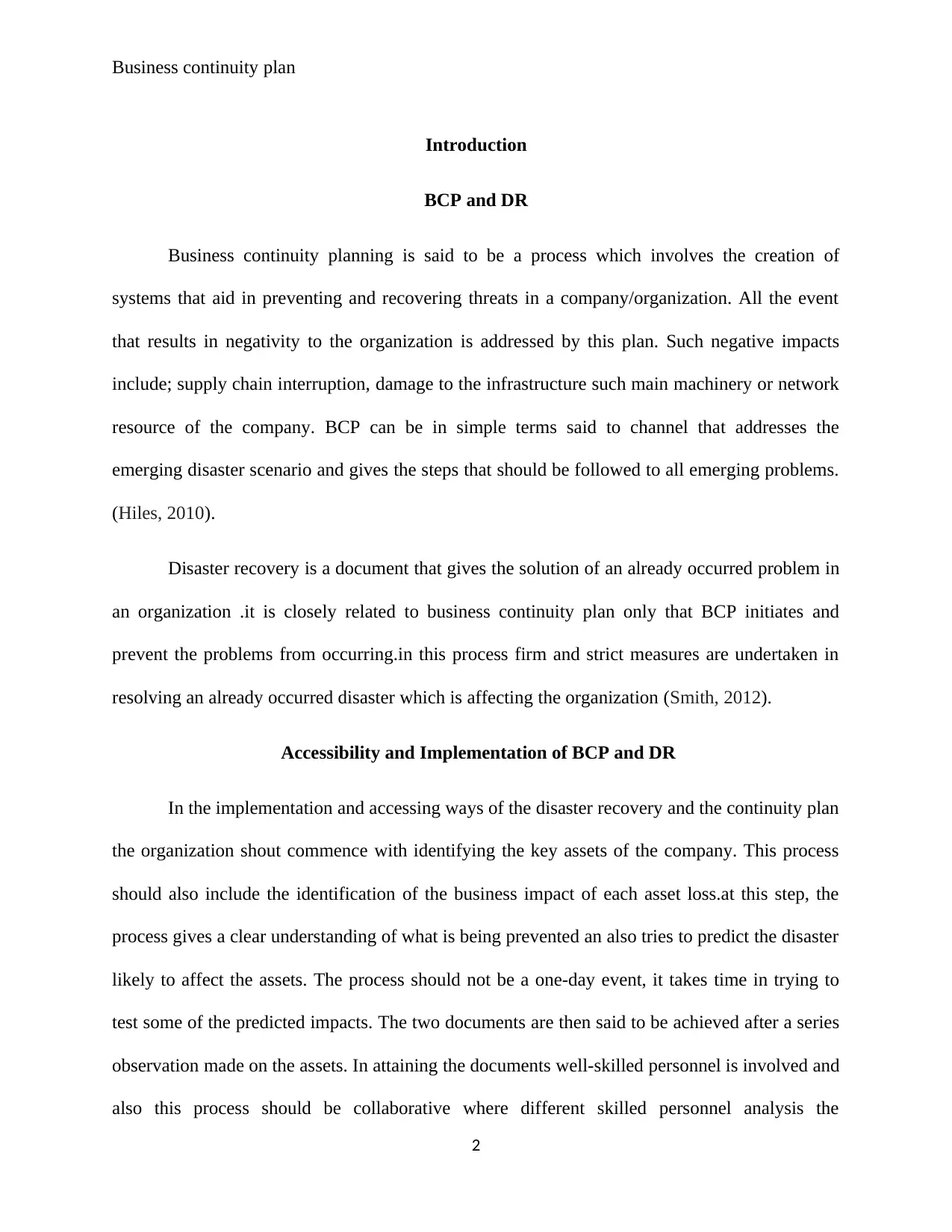
Business continuity plan
Introduction
BCP and DR
Business continuity planning is said to be a process which involves the creation of
systems that aid in preventing and recovering threats in a company/organization. All the event
that results in negativity to the organization is addressed by this plan. Such negative impacts
include; supply chain interruption, damage to the infrastructure such main machinery or network
resource of the company. BCP can be in simple terms said to channel that addresses the
emerging disaster scenario and gives the steps that should be followed to all emerging problems.
(Hiles, 2010).
Disaster recovery is a document that gives the solution of an already occurred problem in
an organization .it is closely related to business continuity plan only that BCP initiates and
prevent the problems from occurring.in this process firm and strict measures are undertaken in
resolving an already occurred disaster which is affecting the organization (Smith, 2012).
Accessibility and Implementation of BCP and DR
In the implementation and accessing ways of the disaster recovery and the continuity plan
the organization shout commence with identifying the key assets of the company. This process
should also include the identification of the business impact of each asset loss.at this step, the
process gives a clear understanding of what is being prevented an also tries to predict the disaster
likely to affect the assets. The process should not be a one-day event, it takes time in trying to
test some of the predicted impacts. The two documents are then said to be achieved after a series
observation made on the assets. In attaining the documents well-skilled personnel is involved and
also this process should be collaborative where different skilled personnel analysis the
2
Introduction
BCP and DR
Business continuity planning is said to be a process which involves the creation of
systems that aid in preventing and recovering threats in a company/organization. All the event
that results in negativity to the organization is addressed by this plan. Such negative impacts
include; supply chain interruption, damage to the infrastructure such main machinery or network
resource of the company. BCP can be in simple terms said to channel that addresses the
emerging disaster scenario and gives the steps that should be followed to all emerging problems.
(Hiles, 2010).
Disaster recovery is a document that gives the solution of an already occurred problem in
an organization .it is closely related to business continuity plan only that BCP initiates and
prevent the problems from occurring.in this process firm and strict measures are undertaken in
resolving an already occurred disaster which is affecting the organization (Smith, 2012).
Accessibility and Implementation of BCP and DR
In the implementation and accessing ways of the disaster recovery and the continuity plan
the organization shout commence with identifying the key assets of the company. This process
should also include the identification of the business impact of each asset loss.at this step, the
process gives a clear understanding of what is being prevented an also tries to predict the disaster
likely to affect the assets. The process should not be a one-day event, it takes time in trying to
test some of the predicted impacts. The two documents are then said to be achieved after a series
observation made on the assets. In attaining the documents well-skilled personnel is involved and
also this process should be collaborative where different skilled personnel analysis the
2
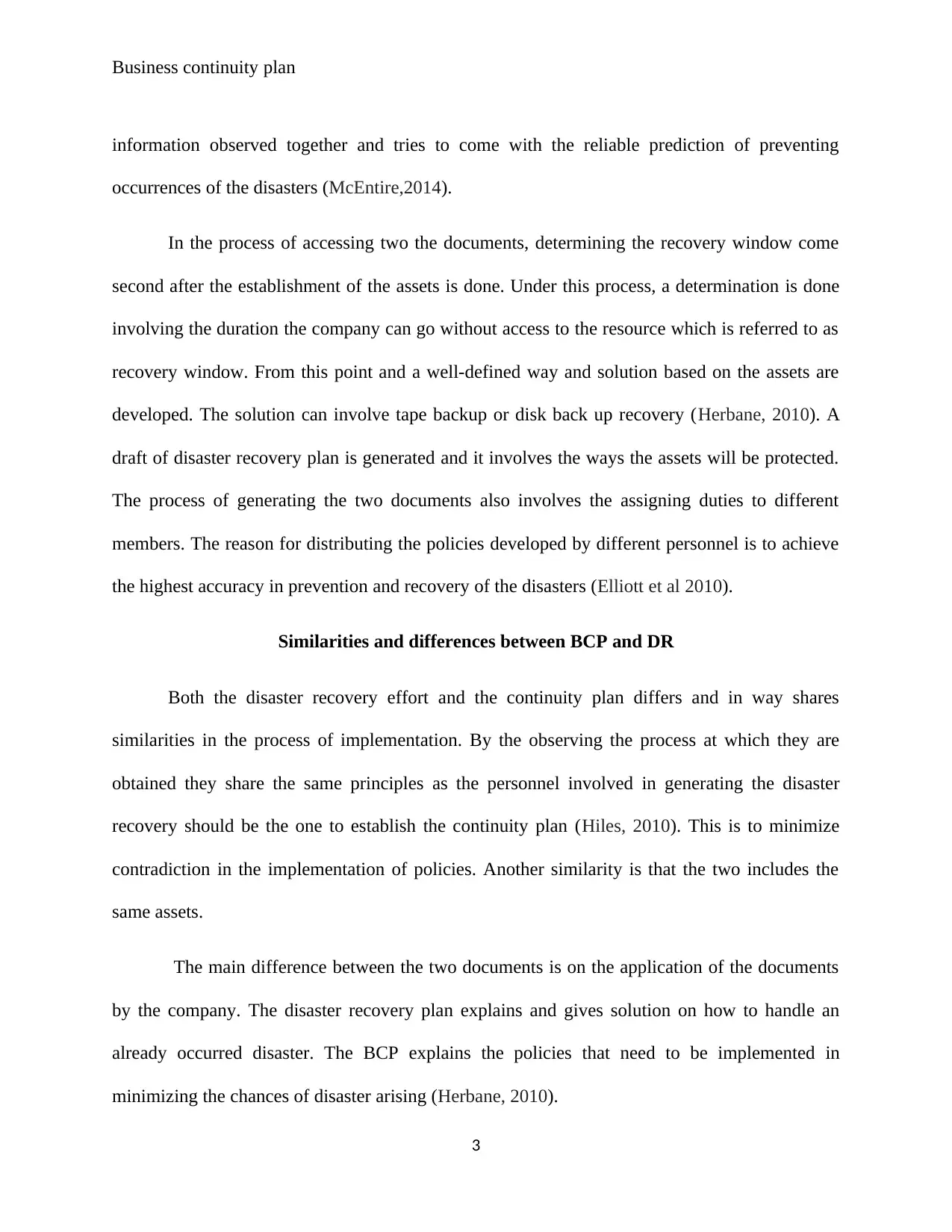
Business continuity plan
information observed together and tries to come with the reliable prediction of preventing
occurrences of the disasters (McEntire,2014).
In the process of accessing two the documents, determining the recovery window come
second after the establishment of the assets is done. Under this process, a determination is done
involving the duration the company can go without access to the resource which is referred to as
recovery window. From this point and a well-defined way and solution based on the assets are
developed. The solution can involve tape backup or disk back up recovery (Herbane, 2010). A
draft of disaster recovery plan is generated and it involves the ways the assets will be protected.
The process of generating the two documents also involves the assigning duties to different
members. The reason for distributing the policies developed by different personnel is to achieve
the highest accuracy in prevention and recovery of the disasters (Elliott et al 2010).
Similarities and differences between BCP and DR
Both the disaster recovery effort and the continuity plan differs and in way shares
similarities in the process of implementation. By the observing the process at which they are
obtained they share the same principles as the personnel involved in generating the disaster
recovery should be the one to establish the continuity plan (Hiles, 2010). This is to minimize
contradiction in the implementation of policies. Another similarity is that the two includes the
same assets.
The main difference between the two documents is on the application of the documents
by the company. The disaster recovery plan explains and gives solution on how to handle an
already occurred disaster. The BCP explains the policies that need to be implemented in
minimizing the chances of disaster arising (Herbane, 2010).
3
information observed together and tries to come with the reliable prediction of preventing
occurrences of the disasters (McEntire,2014).
In the process of accessing two the documents, determining the recovery window come
second after the establishment of the assets is done. Under this process, a determination is done
involving the duration the company can go without access to the resource which is referred to as
recovery window. From this point and a well-defined way and solution based on the assets are
developed. The solution can involve tape backup or disk back up recovery (Herbane, 2010). A
draft of disaster recovery plan is generated and it involves the ways the assets will be protected.
The process of generating the two documents also involves the assigning duties to different
members. The reason for distributing the policies developed by different personnel is to achieve
the highest accuracy in prevention and recovery of the disasters (Elliott et al 2010).
Similarities and differences between BCP and DR
Both the disaster recovery effort and the continuity plan differs and in way shares
similarities in the process of implementation. By the observing the process at which they are
obtained they share the same principles as the personnel involved in generating the disaster
recovery should be the one to establish the continuity plan (Hiles, 2010). This is to minimize
contradiction in the implementation of policies. Another similarity is that the two includes the
same assets.
The main difference between the two documents is on the application of the documents
by the company. The disaster recovery plan explains and gives solution on how to handle an
already occurred disaster. The BCP explains the policies that need to be implemented in
minimizing the chances of disaster arising (Herbane, 2010).
3
⊘ This is a preview!⊘
Do you want full access?
Subscribe today to unlock all pages.

Trusted by 1+ million students worldwide
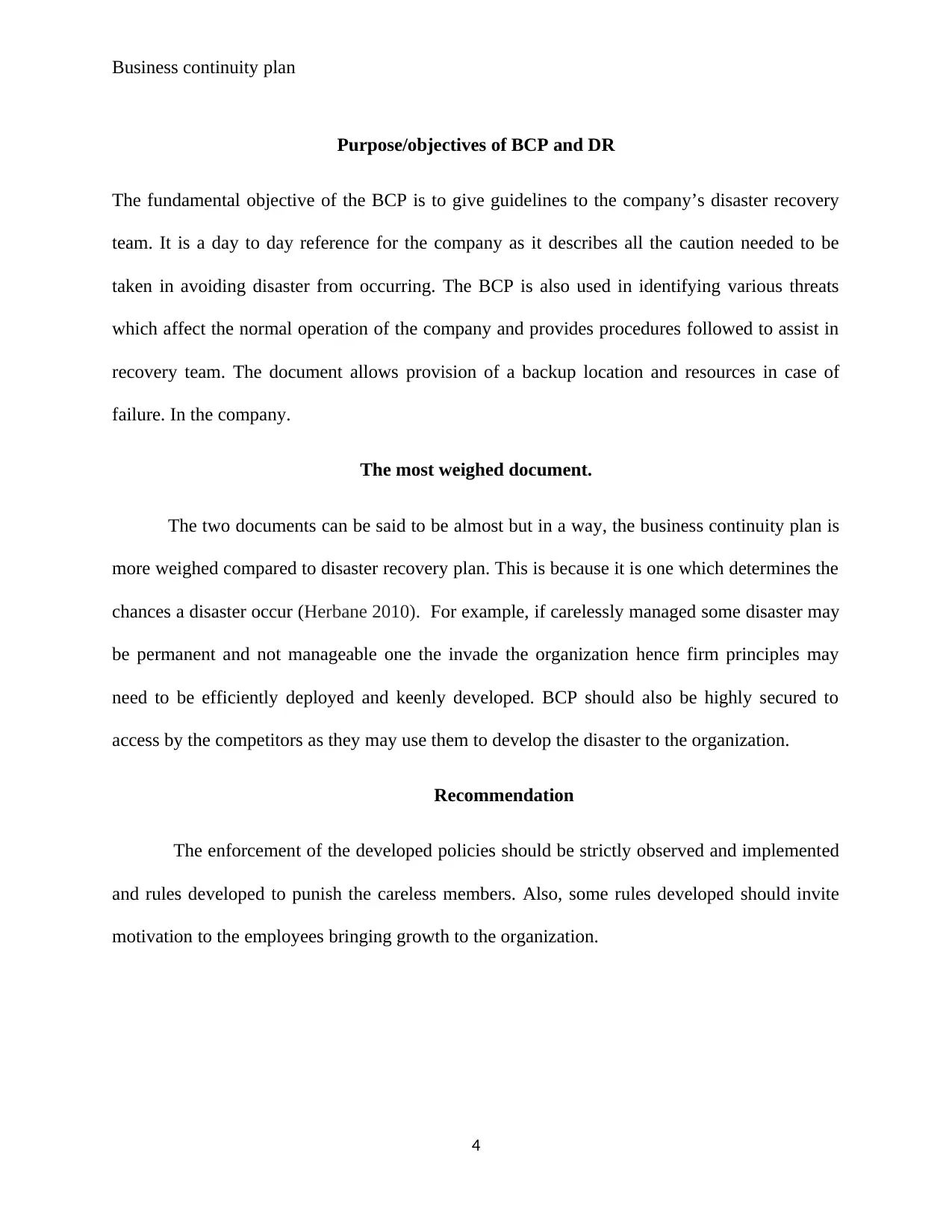
Business continuity plan
Purpose/objectives of BCP and DR
The fundamental objective of the BCP is to give guidelines to the company’s disaster recovery
team. It is a day to day reference for the company as it describes all the caution needed to be
taken in avoiding disaster from occurring. The BCP is also used in identifying various threats
which affect the normal operation of the company and provides procedures followed to assist in
recovery team. The document allows provision of a backup location and resources in case of
failure. In the company.
The most weighed document.
The two documents can be said to be almost but in a way, the business continuity plan is
more weighed compared to disaster recovery plan. This is because it is one which determines the
chances a disaster occur (Herbane 2010). For example, if carelessly managed some disaster may
be permanent and not manageable one the invade the organization hence firm principles may
need to be efficiently deployed and keenly developed. BCP should also be highly secured to
access by the competitors as they may use them to develop the disaster to the organization.
Recommendation
The enforcement of the developed policies should be strictly observed and implemented
and rules developed to punish the careless members. Also, some rules developed should invite
motivation to the employees bringing growth to the organization.
4
Purpose/objectives of BCP and DR
The fundamental objective of the BCP is to give guidelines to the company’s disaster recovery
team. It is a day to day reference for the company as it describes all the caution needed to be
taken in avoiding disaster from occurring. The BCP is also used in identifying various threats
which affect the normal operation of the company and provides procedures followed to assist in
recovery team. The document allows provision of a backup location and resources in case of
failure. In the company.
The most weighed document.
The two documents can be said to be almost but in a way, the business continuity plan is
more weighed compared to disaster recovery plan. This is because it is one which determines the
chances a disaster occur (Herbane 2010). For example, if carelessly managed some disaster may
be permanent and not manageable one the invade the organization hence firm principles may
need to be efficiently deployed and keenly developed. BCP should also be highly secured to
access by the competitors as they may use them to develop the disaster to the organization.
Recommendation
The enforcement of the developed policies should be strictly observed and implemented
and rules developed to punish the careless members. Also, some rules developed should invite
motivation to the employees bringing growth to the organization.
4
Paraphrase This Document
Need a fresh take? Get an instant paraphrase of this document with our AI Paraphraser
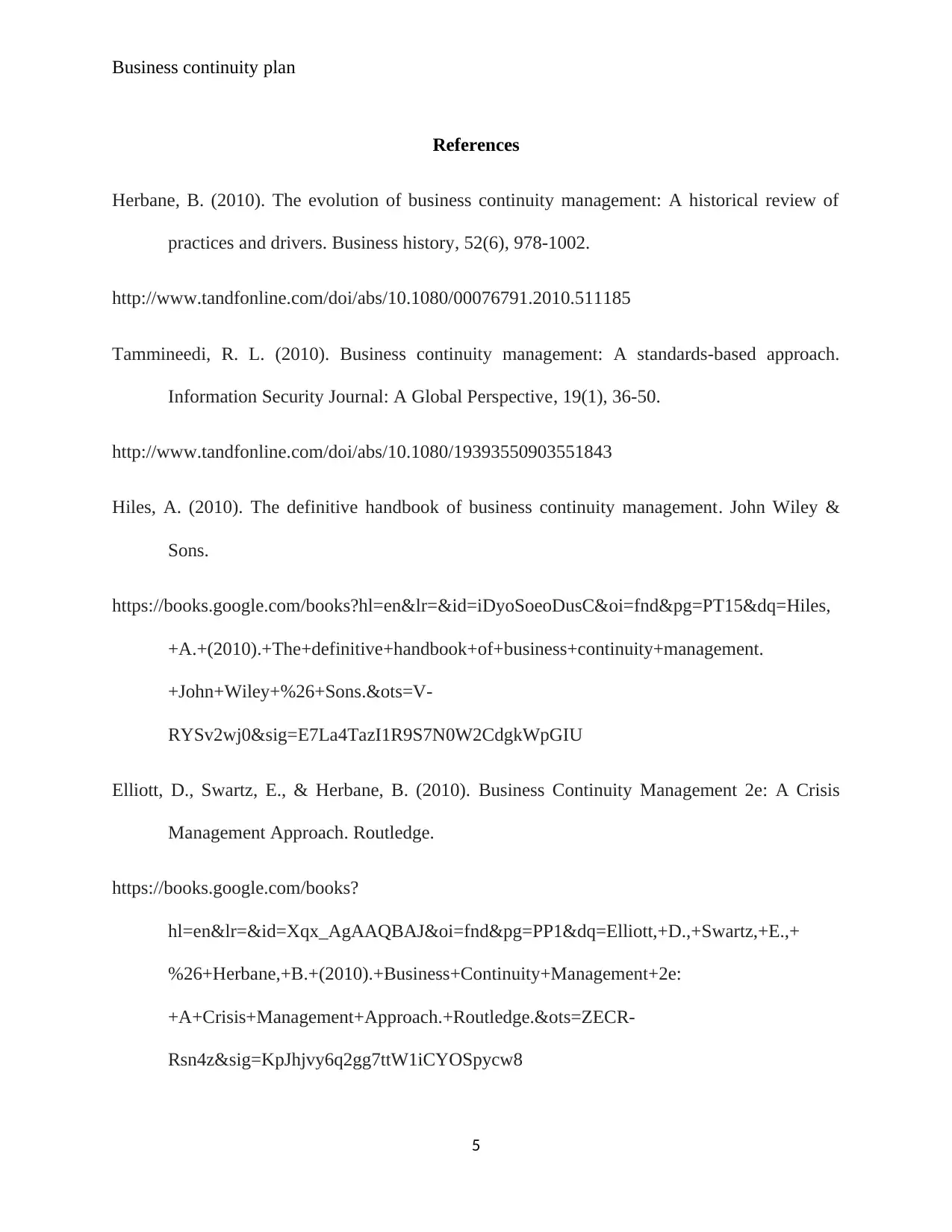
Business continuity plan
References
Herbane, B. (2010). The evolution of business continuity management: A historical review of
practices and drivers. Business history, 52(6), 978-1002.
http://www.tandfonline.com/doi/abs/10.1080/00076791.2010.511185
Tammineedi, R. L. (2010). Business continuity management: A standards-based approach.
Information Security Journal: A Global Perspective, 19(1), 36-50.
http://www.tandfonline.com/doi/abs/10.1080/19393550903551843
Hiles, A. (2010). The definitive handbook of business continuity management. John Wiley &
Sons.
https://books.google.com/books?hl=en&lr=&id=iDyoSoeoDusC&oi=fnd&pg=PT15&dq=Hiles,
+A.+(2010).+The+definitive+handbook+of+business+continuity+management.
+John+Wiley+%26+Sons.&ots=V-
RYSv2wj0&sig=E7La4TazI1R9S7N0W2CdgkWpGIU
Elliott, D., Swartz, E., & Herbane, B. (2010). Business Continuity Management 2e: A Crisis
Management Approach. Routledge.
https://books.google.com/books?
hl=en&lr=&id=Xqx_AgAAQBAJ&oi=fnd&pg=PP1&dq=Elliott,+D.,+Swartz,+E.,+
%26+Herbane,+B.+(2010).+Business+Continuity+Management+2e:
+A+Crisis+Management+Approach.+Routledge.&ots=ZECR-
Rsn4z&sig=KpJhjvy6q2gg7ttW1iCYOSpycw8
5
References
Herbane, B. (2010). The evolution of business continuity management: A historical review of
practices and drivers. Business history, 52(6), 978-1002.
http://www.tandfonline.com/doi/abs/10.1080/00076791.2010.511185
Tammineedi, R. L. (2010). Business continuity management: A standards-based approach.
Information Security Journal: A Global Perspective, 19(1), 36-50.
http://www.tandfonline.com/doi/abs/10.1080/19393550903551843
Hiles, A. (2010). The definitive handbook of business continuity management. John Wiley &
Sons.
https://books.google.com/books?hl=en&lr=&id=iDyoSoeoDusC&oi=fnd&pg=PT15&dq=Hiles,
+A.+(2010).+The+definitive+handbook+of+business+continuity+management.
+John+Wiley+%26+Sons.&ots=V-
RYSv2wj0&sig=E7La4TazI1R9S7N0W2CdgkWpGIU
Elliott, D., Swartz, E., & Herbane, B. (2010). Business Continuity Management 2e: A Crisis
Management Approach. Routledge.
https://books.google.com/books?
hl=en&lr=&id=Xqx_AgAAQBAJ&oi=fnd&pg=PP1&dq=Elliott,+D.,+Swartz,+E.,+
%26+Herbane,+B.+(2010).+Business+Continuity+Management+2e:
+A+Crisis+Management+Approach.+Routledge.&ots=ZECR-
Rsn4z&sig=KpJhjvy6q2gg7ttW1iCYOSpycw8
5
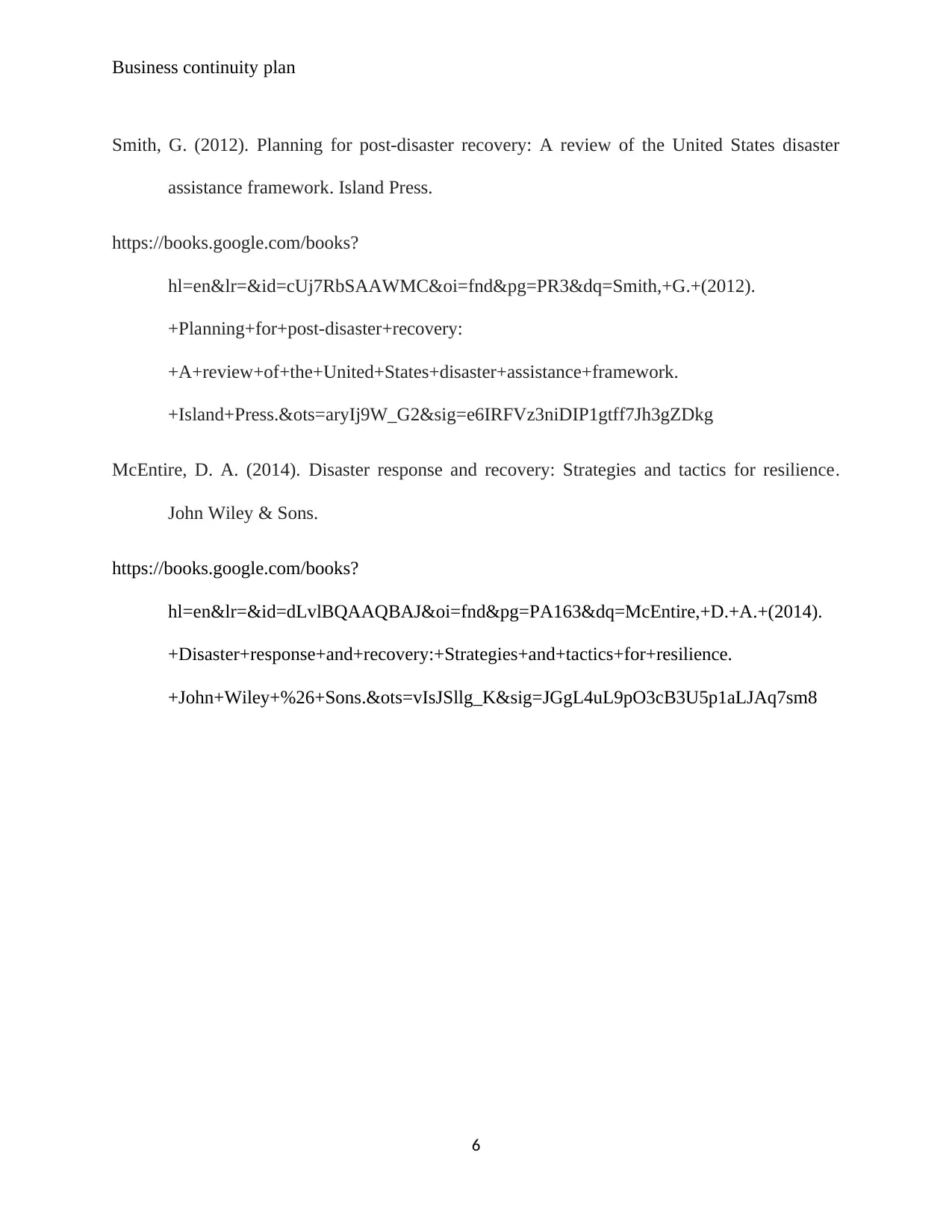
Business continuity plan
Smith, G. (2012). Planning for post-disaster recovery: A review of the United States disaster
assistance framework. Island Press.
https://books.google.com/books?
hl=en&lr=&id=cUj7RbSAAWMC&oi=fnd&pg=PR3&dq=Smith,+G.+(2012).
+Planning+for+post-disaster+recovery:
+A+review+of+the+United+States+disaster+assistance+framework.
+Island+Press.&ots=aryIj9W_G2&sig=e6IRFVz3niDIP1gtff7Jh3gZDkg
McEntire, D. A. (2014). Disaster response and recovery: Strategies and tactics for resilience.
John Wiley & Sons.
https://books.google.com/books?
hl=en&lr=&id=dLvlBQAAQBAJ&oi=fnd&pg=PA163&dq=McEntire,+D.+A.+(2014).
+Disaster+response+and+recovery:+Strategies+and+tactics+for+resilience.
+John+Wiley+%26+Sons.&ots=vIsJSllg_K&sig=JGgL4uL9pO3cB3U5p1aLJAq7sm8
6
Smith, G. (2012). Planning for post-disaster recovery: A review of the United States disaster
assistance framework. Island Press.
https://books.google.com/books?
hl=en&lr=&id=cUj7RbSAAWMC&oi=fnd&pg=PR3&dq=Smith,+G.+(2012).
+Planning+for+post-disaster+recovery:
+A+review+of+the+United+States+disaster+assistance+framework.
+Island+Press.&ots=aryIj9W_G2&sig=e6IRFVz3niDIP1gtff7Jh3gZDkg
McEntire, D. A. (2014). Disaster response and recovery: Strategies and tactics for resilience.
John Wiley & Sons.
https://books.google.com/books?
hl=en&lr=&id=dLvlBQAAQBAJ&oi=fnd&pg=PA163&dq=McEntire,+D.+A.+(2014).
+Disaster+response+and+recovery:+Strategies+and+tactics+for+resilience.
+John+Wiley+%26+Sons.&ots=vIsJSllg_K&sig=JGgL4uL9pO3cB3U5p1aLJAq7sm8
6
⊘ This is a preview!⊘
Do you want full access?
Subscribe today to unlock all pages.

Trusted by 1+ million students worldwide
1 out of 6
Related Documents
Your All-in-One AI-Powered Toolkit for Academic Success.
+13062052269
info@desklib.com
Available 24*7 on WhatsApp / Email
![[object Object]](/_next/static/media/star-bottom.7253800d.svg)
Unlock your academic potential
Copyright © 2020–2025 A2Z Services. All Rights Reserved. Developed and managed by ZUCOL.





